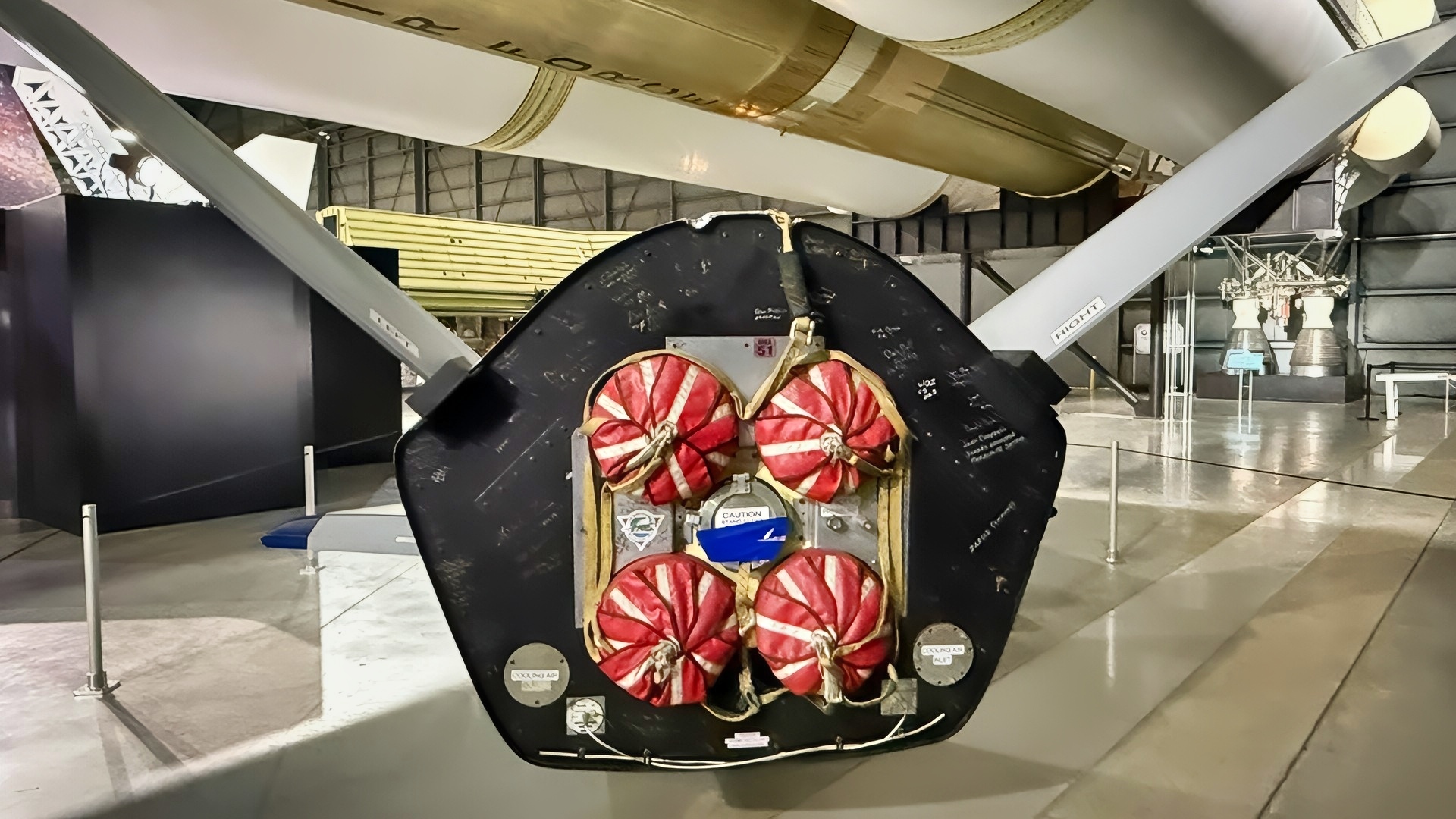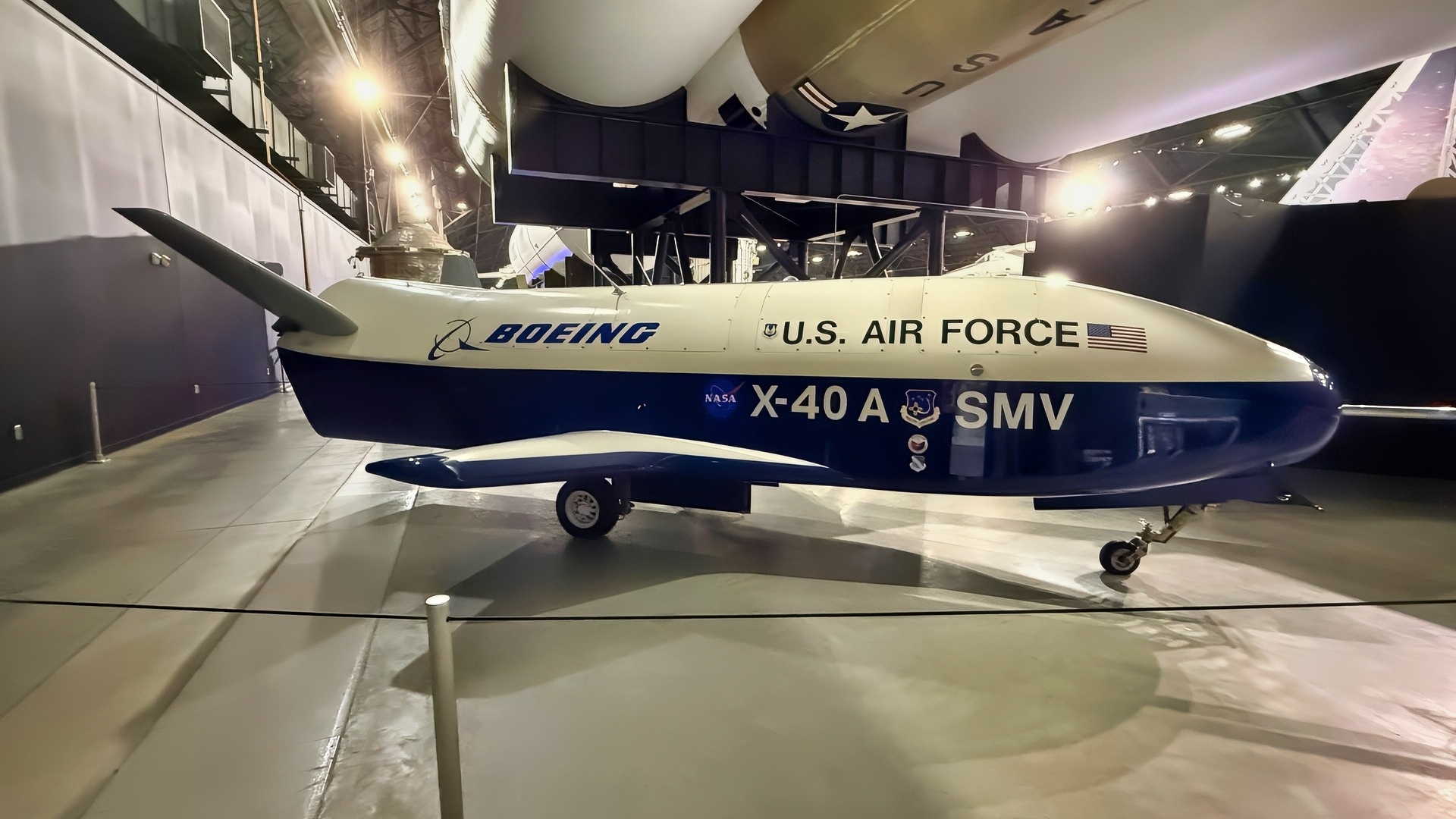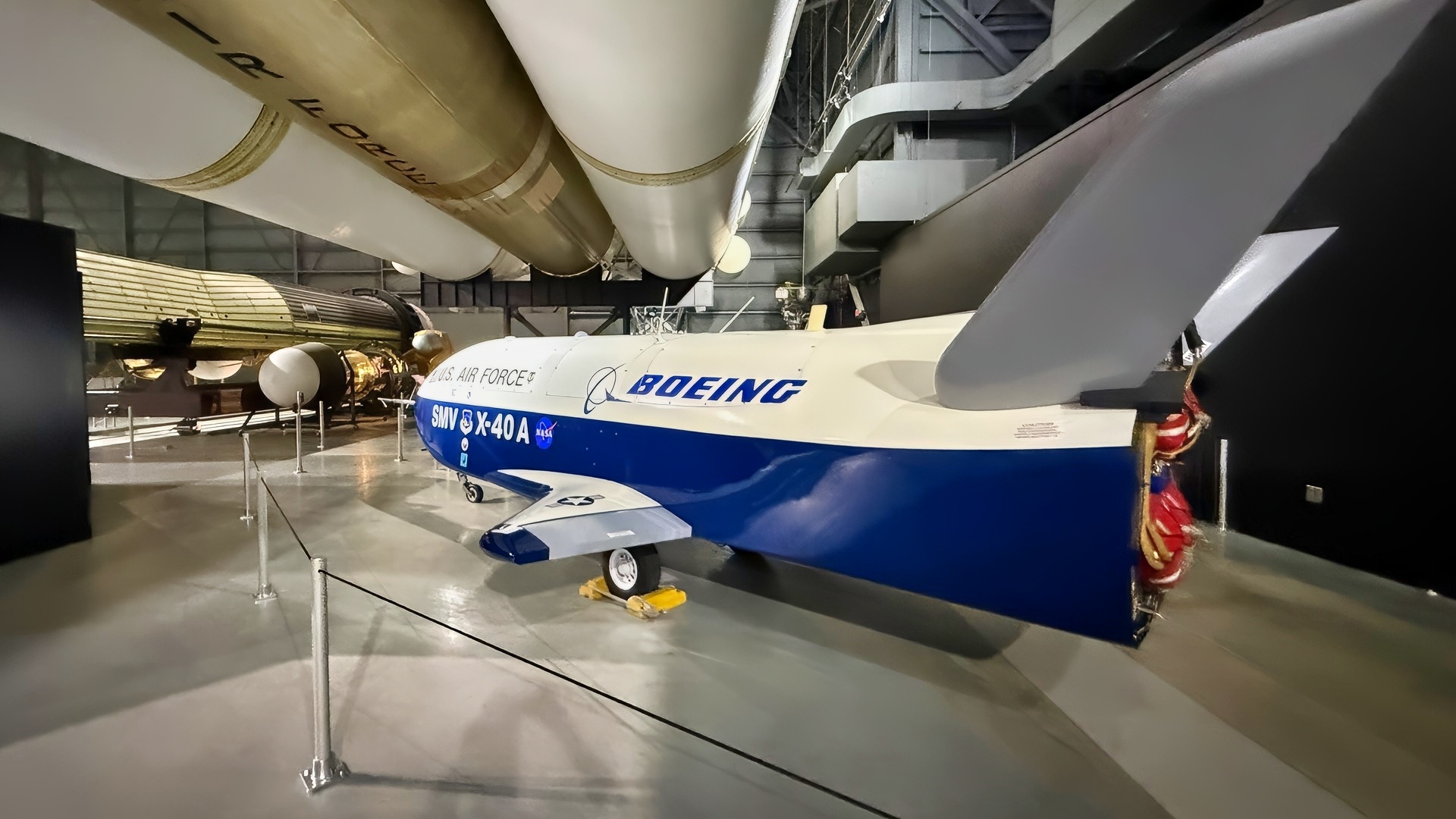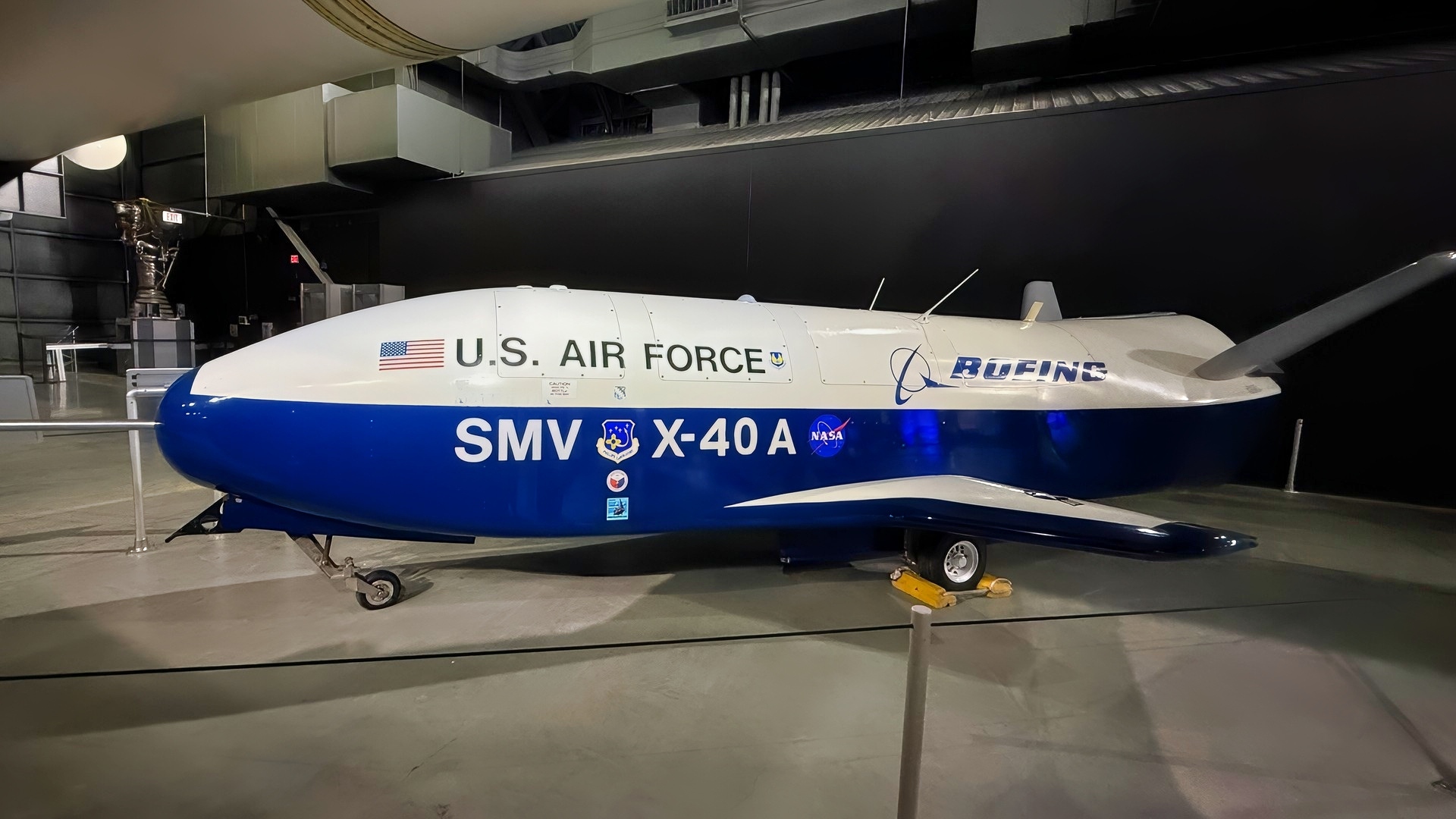Key Points and Summary – Boeing’s X-40A was a subscale, unpowered Space Maneuver Vehicle built to retire the riskiest part of a reusable spaceplane mission: autonomous approach, flare, and runway landing.
-Air-dropped from a helicopter, it proved the shape, mass properties, and GN&C stack—GPS/INS, altimetry, sensor fusion, and control laws driving elevons and canted fins—could manage steep, high-L/D glides, crosswinds, ground effect, touchdown, and anti-skid rollout.

X-40A from USAF Museum. Image by Harry J. Kazianis/National Security Journal.
-Incremental flights surfaced issues in flare timing, brake energy, and gain scheduling that were fixed and re-flown.
-Those lessons flowed directly into the orbital X-37B, whose precise, fully autonomous landings validate X-40A’s core achievement: making runway return from space routine.
Bonus – The author took the photos presented in this essay during his visit to the U.S. Air Force Museum in Dayton, Ohio, where the X-40A is on display. Photos taken on July 19, 2025.
X-40A Space Maneuver Vehicle: The Subscale Spaceplane That Taught America How To Land Autonomously From Space
The idea behind the Space Maneuver Vehicle (SMV) emerged as the Cold War ended but space stayed contested. U.S. planners wanted something reusable that could reenter precisely, land on a runway, and be turned around quickly for the next mission.
Where the Space Shuttle was a crewed, heavy-lift truck, the SMV concept was a small, uncrewed, autonomous spaceplane—part technology pathfinder, part operational seed for quick-reaction tasks: inspection of spacecraft, on-orbit experiments, small payload return, and discreet reconnaissance.
But nobody was going to leap directly to an orbital vehicle without risk retirement. The crucial question was not “can we launch?”—rockets can do that—but “can we come home reliably, in all sorts of winds and weather, and put the vehicle on a centerline using only its own brains?” The Air Force and Boeing built the X-40A to answer that question first.

X-40A Photo National Security Journal Original Photo. Credit: Harry J. Kazianis.
Why Build A Subscale Vehicle First
A subscale, unpowered vehicle lets engineers harvest the hardest lessons early, fast, and affordably:
Autonomy And Guidance: Validate the algorithms that steer from high-energy, high-glide-ratio final approaches through flare and rollout.
Aerodynamics Near The Ground: Measure lift, drag, and control authority in the last mile where ground effect, crosswinds, and gusts make or break landings.
Mass Properties And Handling: Prove that center of gravity placement, moments of inertia, and control-surface sizing scale the way simulations predict.
Touchdown Mechanics: Exercise landing-gear loads, brake/anti-skid logic, and runway tracking after wheel-spin-up—none of which a rocket test stand can teach.
The X-40A was thus a final-approach and landing laboratory—a surrogate that copied the would-be orbiter’s outer mold line, aerodynamic control layout, and mass distribution (scaled), without the cost and risk of building an orbital thermal-protection system and propulsion on day one.

X-40A Side View. Image by Harry J. Kazianis for National Security Journal.
The Engineering: A Small Winged Reentry Body With Big Brains
The X-40A looked like a compact winged lifting-body: a blunt nose and curved belly to survive reentry on the full-scale design, a straight trailing edge with elevons, and canted vertical fins for yaw stability and control. Under the skin, it was a study in GN&C (Guidance, Navigation, and Control) discipline:
Navigation Suite: A tightly integrated GPS/INS core gave position, velocity, and attitude; radar or laser altimetry provided precise height-above-runway to time the flare; air-data sensors resolved wind and angle of attack in the subsonic approach.
Autopilot & Control Laws: Robust energy-management logic commanded elevons and rudders to keep the vehicle on a steep, high-L/D glide—much higher sink rate than an airliner—and then transitioned to a precisely timed flare.
Actuation & Redundancy: Electrically driven actuators moved control surfaces with fail-safe modes; the software could handle surface rate limits, sensor dropouts, and cross-control to keep the vehicle stable.
Landing Gear & Braking: A simple, robust landing-gear system with anti-skid braking and differential brake steering kept the vehicle centered after touchdown at relatively high approach speeds for its size.
Crucially, the X-40A had no air-breathing engine. It was designed to be dropped from a helicopter at altitude, dive onto a defined approach path, and let the algorithms prove that the airframe and software could stick the landing—repeatably.
How The Tests Worked
A heavy-lift helicopter ferried the vehicle to altitude and then released it on a defined track. The X-40A pitched to capture the energy profile, bled speed toward the approach, then made a fully autonomous landing on a prepared runway. Test cards varied the release altitude, winds, and crosswind components; engineers tweaked gain schedules, flare timing, and brake logic between flights.
This approach was deliberately incremental. Instead of one complicated end-to-end demo, the team conducted a series of repeatable sorties, each aimed at closing a handful of technical questions: how much elevon authority did the flare need in gusts? Where did ground effect start to bias the glide-slope? How sensitive was the rollout to asymmetric wheel-spin-up?
Program History In Brief
Conception And Build: The Air Force contracted Boeing in the late 1990s to build a subscale SMV, roughly 85% of the later X-37’s size by outer mold line—large enough to be dynamically meaningful, small enough to lift under a helicopter and move around the test range easily.
First Free Flights: The X-40A performed its initial unpowered drops and landings to prove the basic guidance and landing logic. The success of those sorties validated the shape, the mass properties, and the autonomy stack.
NASA Partnership And Expanded Tests: As NASA pursued a parallel winged-reentry technology path, the X-40A moved into a joint test campaign that added more flights, refined the control laws, and built confidence for a larger, higher-fidelity demonstrator.
Transition To X-37: With the subscale work complete, the lessons flowed to the X-37 program—initially a NASA technology demonstrator and ultimately the U.S. Space Force’s long-duration, uncrewed spaceplane, the X-37B.
While the X-40A never went to space, that was the point: prove the hardest atmospheric piece first, then invest in the rest.
What The Flights Proved—And What Surprised Engineers
Autonomy That Flies Like A Test Pilot. The vehicle’s energy-management logic consistently captured steep glides, corrected for winds, and executed a repeatable flare to wheels-on without pilot stick-jockeying. Flight data showed the controller could manage gust-induced oscillations and hold centerline with differential braking.
Aerodynamics In Ground Effect. Close to the runway, pressure fields shift. The X-40A quantified exactly where lift “comes alive” as the vehicle enters ground effect—vital for timing the flare and preventing ballooning.
Crosswind And Sideslip Handling. Free flights mapped the sideslip envelope and refined rudder-elevon coordination to keep the vehicle tracking the runway with minimal crab angle, reducing side loads on the landing gear.
Touchdown And Rollout Loads. High sink rates and compact gear make spin-up and weight-on-wheels logic delicate. The team tuned anti-skid to avoid lockups on touchdown and calibrated steering gains so the vehicle didn’t “hunt” on the runway.
Software Robustness. The most satisfying result might be the most boring: the autonomy stack handled sensor anomalies, noisy data, and actuator rate limits without losing the thread. That resilience is exactly what an orbital vehicle needs on the one landing that counts.
Problems, Scrapes, And Engineering Adjustments
No landing program graduates without scuffs. Early sorties exposed flare-timing sensitivities in gusty conditions; controllers were updated with altitude-rate blending and smarter cues from the altimeter. One test showed brake-temperature margins were thinner than expected on hot-day landings; brake timing and rollout profiles were adjusted. Another highlighted that center-of-gravity placement—even within allowed bounds—nudged pitch authority near the rotation moment, so the loading plan was tightened and gains re-tuned.
These are exactly the kinds of issues an unpowered demonstrator is perfect for surfacing: they’re subtle enough to hide in simulations, consequential enough to demand fixes before scaling up.
The Design Thread From X-40A To X-37B
The X-37 family inherited the outer mold line logic and autonomy philosophy from X-40A and layered in the orbital pieces:
Thermal Protection: While X-40A didn’t need a full TPS, its shape was chosen with orbital reentry in mind. X-37B adds a reusable tile and leading-edge system designed to survive repeated hypersonic heat cycles without Shuttle-like maintenance burdens.
Propulsion & RCS: X-37B integrates an orbital maneuvering system and a reaction-control system to adjust attitude and perform deorbit—systems the X-40A neatly sidestepped so the team could concentrate on landing.
Power & Payload: X-37B’s deployable solar array and payload bay transform the concept into a long-duration laboratory and delivery van; the X-40A deliberately carried just the avionics and actuation needed to land.
Autonomy, End To End: The runway logic that X-40A proved is now a subset of a larger autonomous chain—on-orbit operations, deorbit burn timing, entry guidance, approach, and landing—executed by the operational spaceplane.
The payoff shows up in the real world: the X-37B has executed multiple multi-hundred-day missions, deorbited precisely, and landed autonomously on a runway—quietly demonstrating a capability the United States did not have in the 1990s.
Why The X-40A Approach Worked
It sounds simple, but it’s rare: solve the hardest piece first, in the cheapest relevant way, with enough fidelity that the result scales. By isolating approach-to-landing with a subscale, unpowered vehicle, the team burned down the highest-risk items for any winged reentry craft: GN&C in the atmosphere, flare timing, and rollout. That let the follow-on program spend money where it mattered next—thermal protection, orbital power, and on-orbit autonomy—knowing the landing piece was not a science project.
Lessons Learned That Still Matter
1) Autonomy Is An Airframe. Control laws aren’t just software; they’re part of the aerodynamic design. The X-40A’s success stemmed from co-designing its shape, control surfaces, sensors, and code, allowing the vehicle to fly like one cohesive organism.
2) Energy Is The Currency. Reentry vehicles live and die on energy management. The program’s emphasis on precise glide-slope capture and flare window timing under variable winds is now standard practice across runway-landing spaceplanes.
3) Redundancy Without Weight. The demonstrator proved you can build graceful degradation into small vehicles—fallback sensor blends, actuator limit handling, and simple, robust logic for rollout—without turning the avionics bay into a mass hog.
4) Test Early, Test Often. Multiple, short, autonomous landings in different conditions taught more, faster, than a single complex end-to-end demo would have. That rhythm—fly, adjust, fly again—is the hallmark of modern flight-test culture.
5) Subscale Done Right Scales Up. Because X-40A matched mass-properties and aerodynamics carefully, its data scaled into X-37B wing loading, control authority, and flare margins with fewer surprises.
How X-40A Enabled Today’s Reusable Spaceplane Reality
The most visible proof is the X-37B itself: a runway-landing, long-duration, uncrewed spaceplane that has deorbited and landed autonomously on multiple missions. Less visibly, X-40A’s results shaped how engineers think about autonomy certification for vehicles that cross from orbital dynamics into the messy air below—how to prove, with flight data, that your controller will behave in corner cases that wind tunnels and desktop simulations only hint at.
Its influence also extends to commercial ambitions. Any firm that dreams of a small, reusable orbital vehicle—for in-space servicing, sample return, or rapid payload turnaround—confronts the same landing truths. The lessons codified in X-40A and, of course, later X-37B—sensor fusion, ground-effect handling, crosswind logic, and rollout control—now read like a checklist for runway-landing spaceplanes.
A Measured Verdict
The X-40A never touched space, never lit a rocket, and never carried a payload bay. Yet it may be one of the most consequential little vehicles of the modern space age. It took the riskiest, most failure-intolerant slice of the mission—autonomous approach, flare, and rollout—and made it boring. In aerospace, “boring” means repeatable, predictable, and ready to hand off to operations.
That is why the program matters. When the X-37B slides onto a runway after hundreds of days aloft, it is executing a landing routine that began life on a helicopter-dropped surrogate whose purpose was not to impress, but to teach.
The X-40A taught well—and America’s reusable spaceplane capability is stronger for it.
About the Author: Harry J. Kazianis
Harry J. Kazianis (@Grecianformula) is Editor-In-Chief and President of National Security Journal. He was the former Senior Director of National Security Affairs at the Center for the National Interest (CFTNI), a foreign policy think tank founded by Richard Nixon based in Washington, DC. Harry has over a decade of experience in think tanks and national security publishing. His ideas have been published in the NY Times, The Washington Post, The Wall Street Journal, CNN, and many other outlets worldwide. He has held positions at CSIS, the Heritage Foundation, the University of Nottingham, and several other institutions related to national security research and studies. He is the former Executive Editor of the National Interest and the Diplomat. He holds a Master’s degree focusing on international affairs from Harvard University.
More Military
Japan Almost Built a 90,000-Ton Battleship
USS Ronald Reagan – The Navy’s Best Aircraft Carrier?
Russia’s Mach 2.83 MiG-31 Foxhound Has a ‘Hypersonic’ Message for NATO
Introducing the F-35EX, F-35FX, and F-35GX: 3 Possible Future ‘Super’ F-35 Fighters










